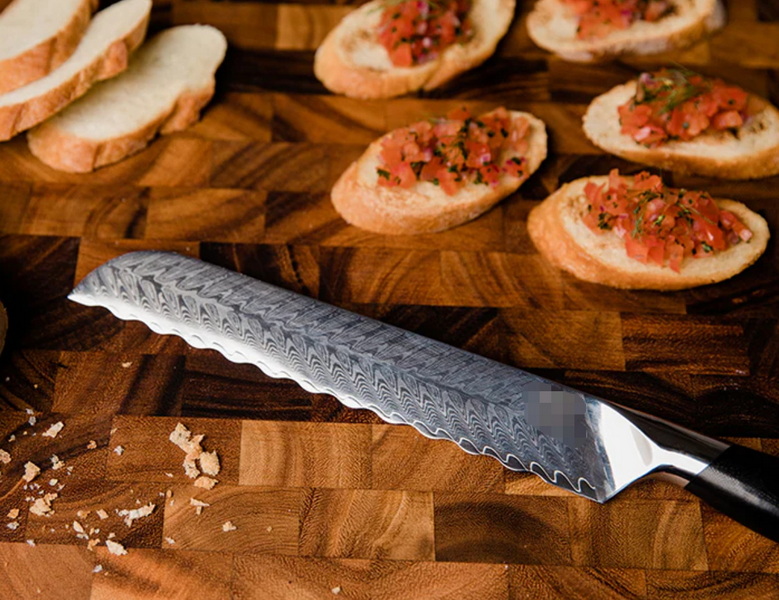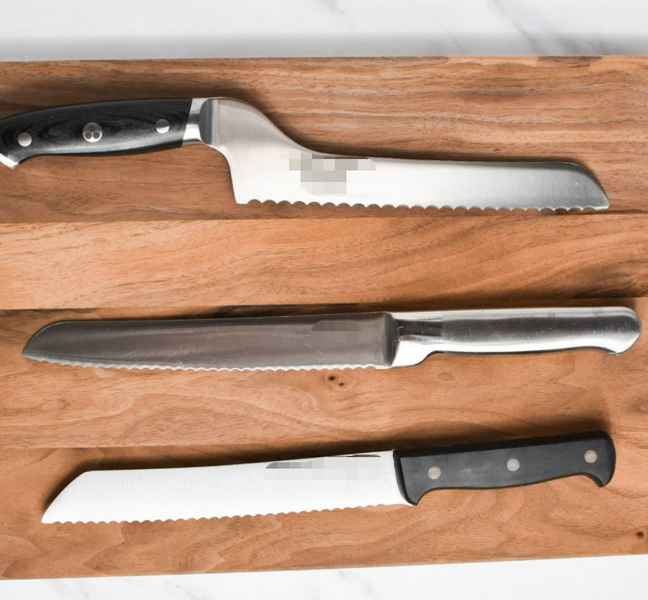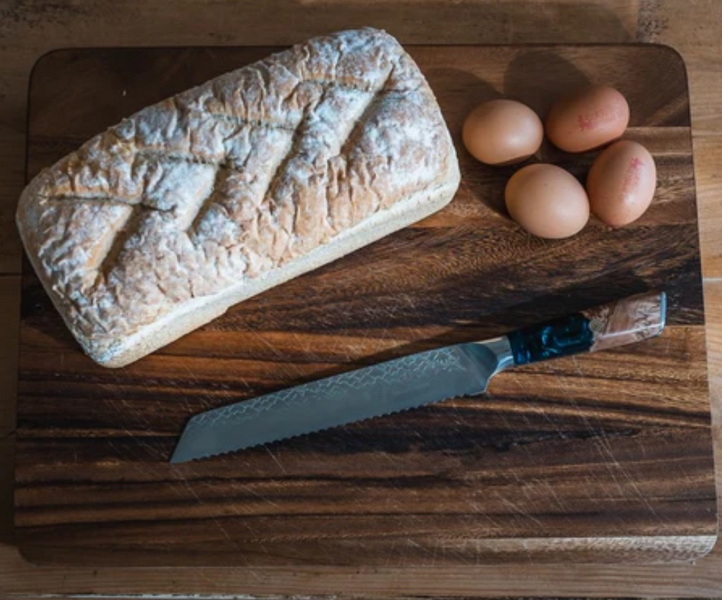- All
- Product Name
- Product Keyword
- Product Model
- Product Summary
- Product Description
- Multi Field Search
Views: 222 Author: Ann Publish Time: 2025-11-05 Origin: Site











Content Menu
● Edge fundamentals for Bread Knives
● When serrated performance matters
● Crust, crumb, and maintenance trade-offs
● Practical buying considerations for OEM buyers
● Design variations and their impact on performance
● Maintenance rituals for longevity
● Real-world scenarios for branding and OEM stories
● FAQ (condensed into a single consolidated section at the end)
>> Q1: Which Bread Knife type is best for crusty artisan bread?
>> Q2: Can a straight edge Bread Knife cut through a crusty loaf effectively?
>> Q3: How should I sharpen a serrated Bread Knife?
>> Q4: How should I care for a Bread Knife to maximize longevity?
>> Q5: Is there a scenario where a Bread Knife with a straight edge is clearly superior?
Bread Knife is a staple tool in professional kitchens and home sets alike. When choosing the right Bread Knife for an OEM program, understanding the real differences between serrated and straight edge variants is essential. This article explores edge geometry, performance across various bread textures, maintenance needs, design considerations for manufacturing, and practical guidance for buyers and brand partners. The discussion centers on how Bread Knife edge types affect crust penetration, crumb integrity, and overall slicing experience, with attention to ergonomic design, material selection, and durability under demanding operating conditions. The goal is to empower foreign brands, wholesalers, and manufacturers with clear, actionable insights for selecting, ordering, and marketing Bread Knife lines that meet diverse global markets.

Bread Knife edges come in two predominant styles: serrated and straight. Serrated edges feature a toothed perimeter that grips and saws through crust, while straight edges rely on a single, continuous sharp bevel for clean, smooth cuts. The different edge geometries interact with bread crust and crumb in distinct ways, influencing slice uniformity, crumb preservation, and ease of use in high-volume settings. For OEM buyers, the choice often hinges on the bread textures most common in target markets and the degree of maintenance convenient for distributors and end users.
Serrated Bread Knives excel with crusty or dense breads such as artisanal loaves, baguettes, sourdoughs, and rustic bread varieties. The serrations start by biting into a hard crust, creating an initial incision with minimal downward pressure, which helps avoid crushing the interior crumb. This makes serrated blades a preferred choice in bakeries and cafés where consistent crust separation and crumb integrity are critical for presentation and portion control. In addition, serrated blades tend to retain their bite longer between sharpenings, a practical advantage in busy environments. From a manufacturing perspective, serration geometry can be optimized for faster entry into crust while maintaining edge durability under multi-shift use.
Straight Edge Bread Knives perform exceptionally well on softer breads and loaves with delicate crumb structures, such as milk bread, brioche, challah, or sandwich loaves. A finely honed straight edge can deliver exceptionally clean, uniform slices with minimal crust disruption in these contexts. However, maintaining a razor-sharp straight edge requires consistent honing and periodic sharpening, particularly in high-volume kitchens or during repetitive slicing tasks. For OEM programs, straight edge design should emphasize blade geometry that yields consistent slice quality across softer textures while minimizing crumb compression.
 Crust, crumb, and maintenance trade-offs
Crust, crumb, and maintenance trade-offs
- Crust penetration: Serrated blades grip crust and initiate cutting with less downward force, reducing crumb damage at the start of the cut. This characteristic is especially valuable for thick or very dense crusts.
- Crumb integrity: Straight edges, when maintained properly, deliver cleaner cuts through soft crumb with less tearing, producing a neater appearance on delicate breads.
- Maintenance cadence: Serrated Bread Knives generally require less frequent sharpening but benefit from occasional professional sharpening to refresh tooth geometry. Straight Bread Knives demand regular honing and periodic sharpening to preserve an optimal edge.
- Material and edge retention: Choose high-carbon stainless steels that balance hardness with corrosion resistance, enabling durable performance in diverse climates and cleaning regimes. A robust alloy helps maintain edge life in automated factory environments and in customer kitchens.
- Blade length and geometry: Typical Bread Knife lengths range from 8 to 12 inches (20–30 cm). Longer blades accommodate large loaves and loaves with tall crusts, while shorter blades offer greater control for precise slicing. For OEM programs, ensure consistency across production lots to maintain uniform performance.
- Handle ergonomics and balance: An ergonomic handle with a balanced weight distribution improves control during long slicing sessions and reduces operator fatigue in high-output settings. Handle materials should be chosen for comfort, grip, and dishwasher compatibility where applicable.
- Sharpening and after-sales service: Serrated blades can be sharpened with specialized tools or by professionals; straight blades benefit from routine honing and periodic re-sharpening. OEM partners should define a clear service plan for customers, including recommended sharpening intervals and authorized maintenance centers.
- Care and cleaning protocols: Emphasize hand washing and thorough drying after use. Dishwasher exposure can accelerate corrosion and edge wear, especially for certain serration patterns and finishes. Clear care guidelines support customer satisfaction and reduce warranty claims.
- Tooth geometry and serration patterns: Variations in tooth size, spacing, and bevel angles influence how quickly crust yields and how crumbs behave at the first contact. Precise tooth geometry can be tailored to target bread types across regional markets.
- Blade thickness and spine height: Blade rigidity affects cutting stability, especially with large or heavy loaves. Moderate thickness offers a balance between bite and flexibility, reducing chatter during slicing.
- Tang and bolster integration: Durable tangs and well-integrated bolsters contribute to overall balance and long-term durability in industrial or professional environments.
- Cleaning: Rinse with warm water, wipe dry promptly, and avoid prolonged exposure to moisture or caustic cleaners that could compromise finishes or edge geometry. Note that some finishes and coatings may have specific care requirements.
- Sharpening regimes: Straight blades benefit from regular honing with a fine rod or ceramic/diamond rod systems, and periodic full sharpening as needed. Serrated blades are sharpened less frequently, typically by professionals, using serration-specific tools to preserve tooth geometry.
- Storage and safety: Store in a protective sheath, blade guard, or knife block to prevent edge damage and to protect users from accidental contact. For OEM packaging, consider blade protection that ships safely while presenting a premium unboxing experience.
- Myth: Serrated knives never need sharpening. Reality: Teeth dull over time and benefit from professional maintenance or targeted upkeep to restore cutting efficiency. [Bread Knife][12]
- Myth: Straight edges always outperform serrated in all bread scenarios. Reality: For crusty breads, serration often yields superior crust separation and crumb preservation; for soft breads, straight edges can provide cleaner cuts when properly maintained.
- Bakery and hospitality settings: High-volume crusty bread cutting benefits from serrated Bread Knives, where edge durability and consistent performance are critical for throughput and presentation. [Bread Knife][10]
- Retail and consumer markets: A dual-knife approach—one serrated and one straight—can address diverse bread textures, delivering versatility for branded product lines and consumer satisfaction. OEM programs may emphasize compatibility with regional bread profiles and maintenance expectations.
Serrated and straight edge Bread Knives each deliver distinct advantages, and the optimal choice—whether for an OEM program or a brand's product line—depends on the bread textures most frequently encountered in target markets and the preferred maintenance cadence. Serrated Bread Knives reliably handle crusty, dense loaves with durable edge performance and crust-first cutting dynamics, while straight Bread Knives excel at producing clean, uniform slices for soft breads when properly sharpened. For mixed-bread environments or when product differentiation is a strategic priority, a dual-knife approach often yields the best user experience and the most consistent branding story across markets. OEM partners can further differentiate by customizing tooth geometry, blade length, handle ergonomics, coatings, and packaging to align with regional preferences and regulatory requirements.

A1: Serrated Bread Knife is typically the preferred option for crusty artisan bread due to its ability to saw through a hard crust while preserving interior crumb.
A2: Yes, with a sharp edge and proper technique, a straight Bread Knife can slice crusty loaves, though it may require more downward pressure and might risk crumb tearing on very dense crusts.
A3: Serrated Bread Knives are typically sharpened using serration-specific sharpeners or by a professional; avoid aggressive grinding that could alter tooth geometry.
A4: Hand washing, prompt drying, appropriate storage, and regular maintenance (honing for straight blades, periodic sharpening for serrated blades) help extend life and performance.
A5: Yes, when slicing soft, delicate breads where a clean, smooth cut is highly desirable and the crust is not overly tough.
The Ultimate Professional Knives for Halal Butchery in Middle Eastern Kitchens
Chef Knife Size Guide: Choosing Between 6″, 8″, 10″, And 12″
Custom Knife Handles: How To Design A Chef Knife That Fits Your Hand Perfectly
Chef Knife Surface Treatments Guide: From Polished Migaki To Damascus Patterns
Inside Our Professional Knife Sample Room: Quality You Can See
Universal Knife Block Buying Guide: Modern Acrylic & ABS Knife Holders for Professional Kitchens
Universal Knife Block: The Complete Guide To Modern, Hygienic Knife Storage
The Complete Guide To Red Handle Knife Sets: Style Meets Functionality in The Kitchen
Professional Knives for Halal Butchery And Middle Eastern Cuisine